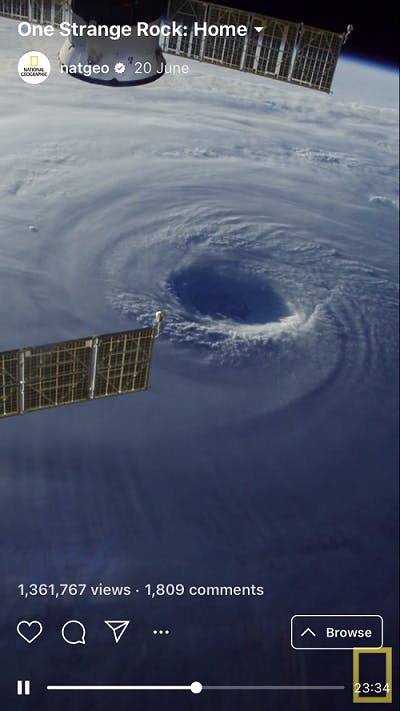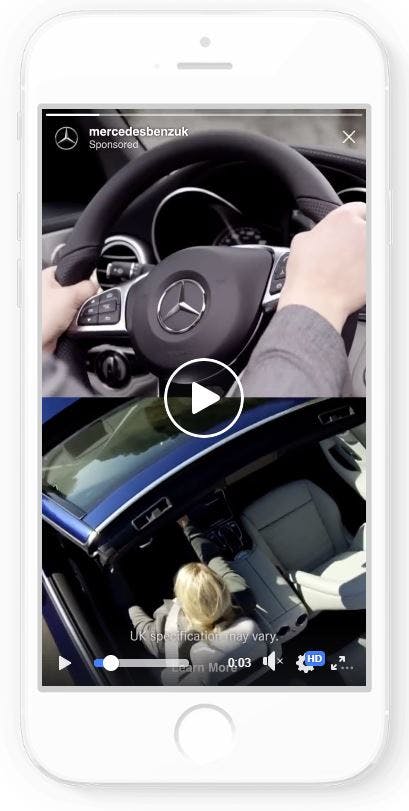Vertical video is nothing new, of course – Snapchat first pioneered the format in 2013. However, along with IGTV, as well as the launch of vertical ads on a number of platforms, we’re now seeing a huge surge in the format.
This is perhaps unsurprising given that the majority of users hold their phones vertically – not to mention the fact that more than 75% of worldwide video viewing happens on mobile.
Vertical video aligns with both of these factors, creating a viewing experience that’s intimate, immersive, and distraction-free.
Not all marketers are so keen to embrace vertical video, it seems, with some brands still persisting with landscape in order to convey greater context and depth. In contrast, we’ve also seen a number of brands embrace and succeed with vertical, perhaps proving why others should take heed.
Here’s just five of them and the reasons why they work.
1. National Geographic
With over 92 million followers, National Geographic is the most followed account on Instagram. Unsurprisingly, it was chosen as the launch partner for IGTV, with the platform airing the full and final episode of National Geo’s “One Strange Rock” documentary. Adapted for vertical screens, the show – hosted by Will Smith – sees astronauts tell the story of Earth.
You might assume that such a visually arresting topic would be better suited to the wider format of 16:9, but interestingly, the 9:16 version helps to create a more immersive feeling. This means that viewers are kept hooked throughout the 47-minute documentary, with content like this ideal for commutes or other times when mobile is the user’s channel of choice.
National Geographic has since published other shorter videos on IGTV, but its long-form doc has been its most watched so far, generating over three million views to date.

2. Spotify
Music videos have traditionally been shot in landscape, aligning with their traditional home of television and channels like MTV. However, as the industry has evolved onto digital platforms, adapting to mobile has now become a big focus.
Spotify has enlisted a number of big name stars to make exclusive vertical videos for its mobile app. Selena Gomez is one notable example, with her “Bad Liar” video first launching on the channel in this format (before being rolled out elsewhere).
For Spotify, the aim has been to build interest in its platform in a more visual capacity, as well as to drive downloads of its mobile app. With a number of artists also creating vertical music videos as well as traditional versions on their own – it seems to be an increasing trend within the music industry.
Check out an exclusive vertical video (and a first look at the official video ???? ) for #BackToYou on @Spotify! https://t.co/428StBVT7a pic.twitter.com/qFXqiv0jon
— Selena Gomez (@selenagomez) May 10, 2018
3. Mercedes-Benz
Mercedes-Benz is another big brand to experiment with vertical video. Its short film, “The First Driver” was produced in vertical format for IGTV. It tells the story of Bertha Benz, who embarked on the first motorised long-distance journey. And while vehicles and winding roads might not be a natural fit for vertical, Mercedes Benz clearly recognises the importance of creating content for all formats.
If a large percentage of users are viewing content on mobile, after all, it surely makes sense to offer content that’s suited to the channel.
As well as IGTV, Mercedes-Benz has previously also experimented with vertical video ads on Instagram. Promoting the new Mercedes-Benz C-Class Cabriolet, the ads involved stacking and split-screen editing techniques, allowing users to view the vehicle in motion from three different angles (at the same time). This allowed the brand to inject greater levels of creativity, action, and excitement.
According to Instagram, the ad reached 2.6 million people, generating a nine-point increase in ad recall, and a three-point lift in message association with the Stories tagline.

4. Netflix
Variety reports that around 20% of all Netflix viewing happens on mobile devices, while over 50% of all Netflix members use their mobile devices to access the service at some point each month. Despite a reliance on TV, the mobile audience is still hard to ignore, resulting in Netflix furthering its investment in mobile-friendly features.
Vertical video is one of the most recent, with the platform introducing previews of new shows in this format. Undeniably similar to Instagram Stories, the previews can be accessed by tapping an icon at the top of the mobile app, and each one is 30 seconds in length.
With search and browsing a core (and perhaps frustrating) part of Netflix’s user experience, this feature certainly makes discovering shows easier. You can also add the TV show movie to your list or watch immediately, proving that vertical video can be utilised for functionality as well as creativity.
5. PureGym
PureGym is a much smaller brand compared to the others mentioned here, but it has scaled up online visibility and awareness thanks to smart advertising.
With its recent vertical video ad campaign on Facebook, it aimed to reach specific locations across the UK, while promoting its new branding and ad design.
Vertical video can be effective for boosting brand awareness in particular, as the format means that viewers are less distracted (with no option to look left or right), and therefore much more focused with their attention. These types of ads can also be more creative, with the option to make use of the vertical height to include multiple angles and scrolling content.
According to Facebook data, PureGym’s vertical ads succeeded in all these areas. The campaign – which ran from 5Th to 28th of February 2018 – resulted in a 33-point lift in ad recall, an 18-point lift in favourability, and a 19-point lift in preference for the brand.

Will more brands take notice?
Snapchat might have pioneered the format, but it’s hard to ignore the role Instagram Stories has played in the growing popularity of vertical video. Stories now has 400 million daily users – twice the number of Snapchat. As a result, advertisers have been taking notice, with Merkle reporting in July that ad spend on Instagram is growing at four times the rate of ad spend on Facebook ads.
Meanwhile, with YouTube launching vertical video ads and platforms like TikTok also getting in on the action, it’s seemingly a case of “follow suit or fall behind”.
For brands investing in mobile video then, vertical seems like a no-brainer, and not just in terms of ads. As National Geographic shows, long-form content can work vertically if it is chosen for the right reasons. In other words – not just to save users the bother of turning their phones, but to align with its creative and intimate style.
Vertical does not automatically guarantee success, of course. There’s always going to be a place for the cinematic style of landscape, for as long as we view content on our TV’s and laptops. And not everyone watches video on mobile anyway, meaning it should be viewed as more of an additional or alternative format, or as part of a platform-specific campaign.
That being said, as the aforementioned brands show, 9:16 can prove to be a creative, immersive, and convenient format for mobile viewers.
Learn more
Econsultancy offers paid social training and a host of social media best practice guides.

Strange idea. Users will rotate their phones to landscape anyway…